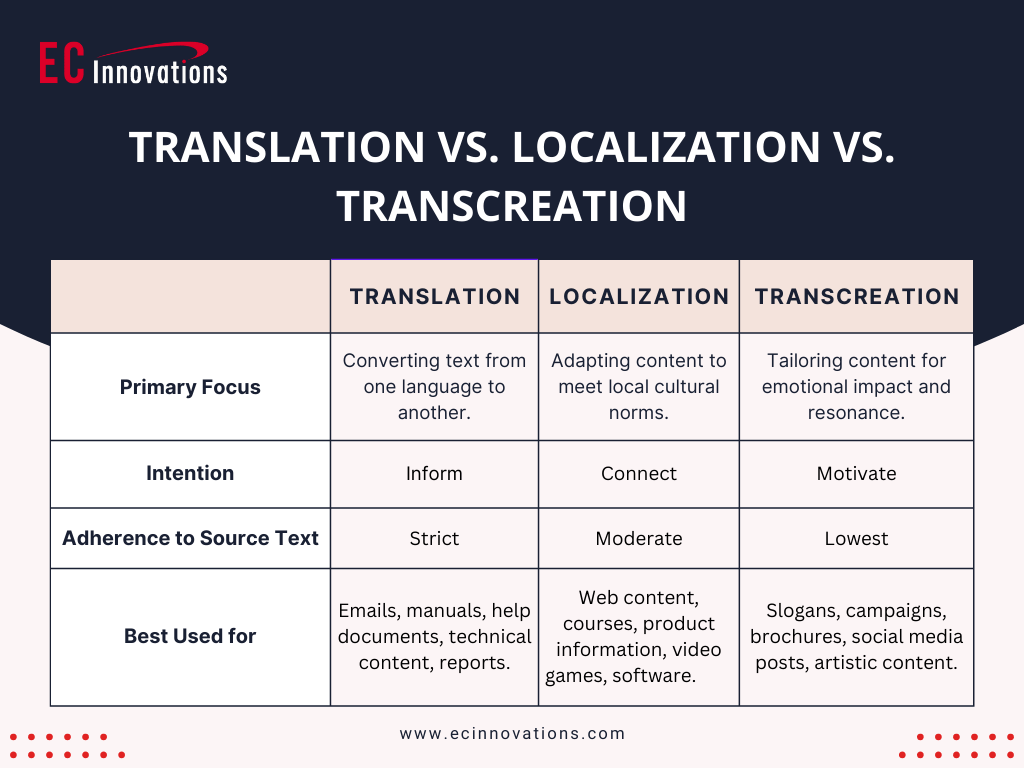Translation, localization, and transcreation—aren’t they all the same? While they do share the common goal of helping your company connect with customers around the world, there are important nuances that set them apart. Understanding these differences can help businesses and organizations develop effective strategies for global engagement. Let’s take a look at each in turn and see how they differ.
What is Translation?
Translation is the process of converting written text from one language to another while preserving the original message. Although it sounds simple, translation is a nuanced and complex task.
In practice, translation requires skill and judgment to ensure the essence and meaning of the source text are captured in the target language. The phrase “lost in translation” underscores the potential pitfalls in this process. For example, when Mercedes-Benz expanded into China, its name was initially translated as “Bensi,” which means “rush to die.” This unfortunate translation was quickly corrected to “Benchi,” meaning “running quickly as if flying,” which is more poetic and positive.
Every translation project involves some degree of interpretation, especially with abstract texts. The more abstract the content, such as poetry, the greater the variation between translations. Each version may be considered correct, but may differ in nuance and emotional impact. In contrast, the translation of technical documents, such as user manuals, tends to be more straightforward, with an emphasis on accuracy and clarity.
The main characteristics of translation are:
- Content Consistency: The core message remains the same.
- Literal Approach: Translation often involves a word-for-word conversion.
- Static Elements: Images, layout, and brand vocabulary typically do not change.
What is Localization?
Localization is the process of adapting content to meet the linguistic, cultural, and contextual nuances of a specific target market. While translation focuses on converting text from one language to another, localization goes beyond mere language conversion to ensure that the content resonates with the local audience as if it were originally created for them.
This means not only translating the words but also adapting various elements such as images, layouts, time and date formats, currencies, units of measurement, and even colors to align with local preferences and norms.
Localization aims to make foreign content feel local, ensuring it is culturally appropriate and appealing to the target audience. This process includes considering local customs, values, and traditions, as well as any regional slang or idioms that might enhance the connection with the audience. For example, in India, McDonald’s offers the McAloo Tikki burger, which caters to the vegetarian preferences and dietary restrictions of many Indian consumers. Similarly, in Japan, McDonald’s offers a Teriyaki Burger to appeal to local tastes.
The main characteristics of localization are:
- Content Adaptation: While the core meaning of the content stays the same, it is adapted to be culturally relevant.
- Cultural Sensitivity: Language and cultural references are tailored to be appropriate and appealing to the local audience.
- Element Modification: Visual and structural elements, such as images, layout, and colors, are adapted to meet local expectations and standards.
What is Transcreation?
Transcreation, a blend of “translation” and “creation,” involves adapting content from one language to another while maintaining its intent, style, tone, and context. This process goes beyond direct translation and localization by focusing on the emotional and cultural impact of the content, ensuring it resonates powerfully with the target audience.
Transcreation is a creative process that allows marketers to tailor their messages to evoke the same emotional response in the new audience as in the original. This often involves reimagining idioms, expressions, cultural references, and even entire narratives to make them relevant and compelling in the target market.
A prime example of transcreation can be seen in global brand marketing campaigns. For example, when Pepsi entered the Chinese market, its slogan “Pepsi brings you back to life” was initially translated literally, resulting in the phrase “Pepsi brings your ancestors back from the grave.” The company quickly realized the need for a more culturally sensitive and emotionally appealing message, demonstrating the critical role of transcreation in global marketing strategies.
The main characteristics of transcreation are:
- Creative Freedom: Unlike traditional translation, transcreation allows for significant changes in the content to ensure it fits the cultural and emotional context of the target audience.
- Emotional Resonance: The goal is to evoke the same feelings and reactions in the target audience as the original message does in its audience.
- Cultural Relevance: Transcreation adapts idioms, expressions, and cultural references to make them meaningful and impactful for the new market.
- Comprehensive Adaptation: This process may involve modifying images, slogans, and other visual elements to suit local tastes and preferences.
What Are The Differences Between Translation, Localization, and Transcreation?
Understanding the differences between translation, localization, and transcreation is crucial for effectively communicating your brand’s message across diverse global markets. Each of these processes serves a unique purpose and is suited to different types of content and objectives. Here’s a closer look at how they differ:

As you consider expanding your global presence, choosing the right language services can make all the difference. As a professional language services provider, EC Innovations offers specialized translation, localization and transcreation services tailored to your specific needs and goals. Whether you’re launching a new product, expanding into international markets, or looking to connect with diverse audiences, our team is here to help. For more information about our range of services and how we can help you, please get in touch at info@ecinnovations.com.




